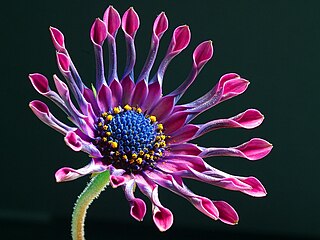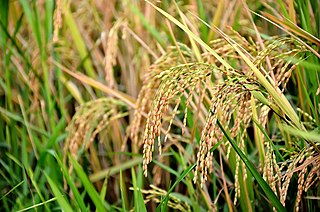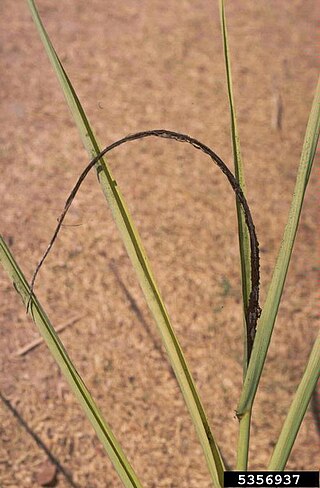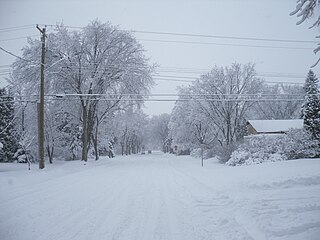
Begonia is a genus of perennial flowering plants in the family Begoniaceae. The genus contains more than 2,000 different plant species. The Begonias are native to moist subtropical and tropical climates. Some species are commonly grown indoors as ornamental houseplants in cooler climates. In cooler climates some species are cultivated outside in summertime for their bright colorful flowers, which have sepals but no petals.

A cultivar is a kind of cultivated plant that people have selected for desired traits and which retains those traits when propagated. Methods used to propagate cultivars include division, root and stem cuttings, offsets, grafting, tissue culture, or carefully controlled seed production. Most cultivars arise from purposeful human manipulation, but some originate from wild plants that have distinctive characteristics. Cultivar names are chosen according to rules of the International Code of Nomenclature for Cultivated Plants (ICNCP), and not all cultivated plants qualify as cultivars. Horticulturists generally believe the word cultivar was coined as a term meaning "cultivated variety".

Oryza sativa, also known as rice, is the plant species most commonly referred to in English as rice. It is the type of farmed rice whose cultivars are most common globally, and was first domesticated in the Yangtze River basin in China 13,500 to 8,200 years ago.

The smuts are multicellular fungi characterized by their large numbers of teliospores. The smuts get their name from a Germanic word for 'dirt' because of their dark, thick-walled, and dust-like teliospores. They are mostly Ustilaginomycetes and comprise seven of the 15 orders of the subphylum. Most described smuts belong to two orders, Ustilaginales and Tilletiales. The smuts are normally grouped with the other basidiomycetes because of their commonalities concerning sexual reproduction.

The Carnivorous Plant Newsletter is the official publication of the International Carnivorous Plant Society (ICPS), the largest such organization in the world. It is headquartered in Walnut Creek, California.

Sugarcane smut is a fungal disease of sugarcane caused by the fungus Sporisorium scitamineum. The disease is known as culmicolous, which describes the outgrowth of fungus of the stalk on the cane. It attacks several sugarcane species and has been reported to occur on a few other grass species as well, but not to a critical amount. The most recognizable characteristic of this disease is a black or gray growth that is referred to as a "smut whip". Resistance to sugarcane smut is the best course of action for management, but also the use of disease free seed is important. On smaller scale operations treatments using hot water and removing infected plants can be effective. The main mode of spore dispersal is the wind but the disease also spreads through the use of infected cuttings. Sugarcane smut is a devastating disease in sugarcane growing areas globally.

The American elm cultivar Ulmus americana 'Augustine', originally called 'Augustine Ascending', was cloned by Archie M. Augustine of the Augustine Nursery of Bloomington, Illinois, from a nursery seedling planted in 1927 in Normal, Illinois, and found to be columnar in habit.

The Chinese Elm cultivar Ulmus parvifolia 'Drake' was marketed by the Monrovia Nursery of Azusa, California from 1952 to 1953.

The Chinese Elm cultivar Ulmus parvifolia 'Sempervirens' is an American introduction, commonly known by the synonym 'Evergreen', and may also be in synonymy for U. parvifolia 'Pendens'.

The Siberian elm cultivar Ulmus pumila 'Hansen' is a little-known American tree of obscure origin, possibly raised from seed collected by the horticulturist and botanist Prof. Niels Hansen during his expedition to Siberia in 1897.
The American elm cultivar Ulmus americana 'Beebe's Weeping' was propagated from a tree growing in the wild at Galena, Illinois, by Mr. E. Beebe in the mid-19th century. Thomas Meehan, who had received cuttings and called it 'Weeping Slippery Elm' before the flowers revealed that it was not Ulmus fulva, suggested the name 'Beebe's Weeping Elm', as there were already U. americana clones called 'Pendula'. In the early 20th century it was marketed, however, as Ulmus 'American Galena Weeping', "American Weeping Elm", by the Klehm nursery of Arlington Heights, Illinois.

The American elm cultivar Ulmus americana 'Beaverlodge' was selected as a seedling in 1925 at the Beaverlodge Experimental Farm, Morden, Manitoba, part of the Lacombe Research Centre, Alberta, for its hardiness and vigour, and released in 1954.
The Chinese Elm cultivar Ulmus parvifolia 'Pendens' was listed by Rehder in Journal of the Arnold Arboretum 26: 473, 1872 as Ulmus parvifolia f. pendens.

Covered smut of barley is caused by the fungus Ustilago hordei. The disease is found worldwide and it is more extensively distributed than either loose smut or false loose smut.

Urocystis agropyri is a fungal plant pathogen that causes flag smut on wheat.

Ustilaginoidea virens, perfect sexual stage Villosiclava virens, is a plant pathogen which causes the disease "false smut" of rice which reduces both grain yield and grain quality. The disease occurs in more than 40 countries, especially in the rice producing countries of Asia. but also in the U.S. As the common name suggests, it is not a true smut (fungus), but an ascomycete. False smut does not replace all or part of the kernel with a mass of black spores, rather sori form erupting through the palea and lemma forming a ball of mycelia, the outermost layers are spore-producing. Infected rice kernels are always destroyed by the disease.
Tilletia horrida, rice kernel smut, caryopsis smut, black smut, or grain smut, is a fungal rice disease believed to only affect the Oryza genus. It presents as a partial bunt.

The Ulmus pumila cultivar 'Aurescens' was introduced by Georg Dieck at the National Arboretum, Zöschen, Germany, circa 1885. Dieck grew the tree from seed collected in the Ili valley, Turkestan by the lawyer and amateur naturalist Vladislav E. Niedzwiecki while in exile there. Dieck originally named the tree U. pinnato-ramosaf.aurescens.

Xanthomonas oryzae pv. oryzae is a bacterial pathovar that causes a serious blight of rice, other grasses, and sedges.
















